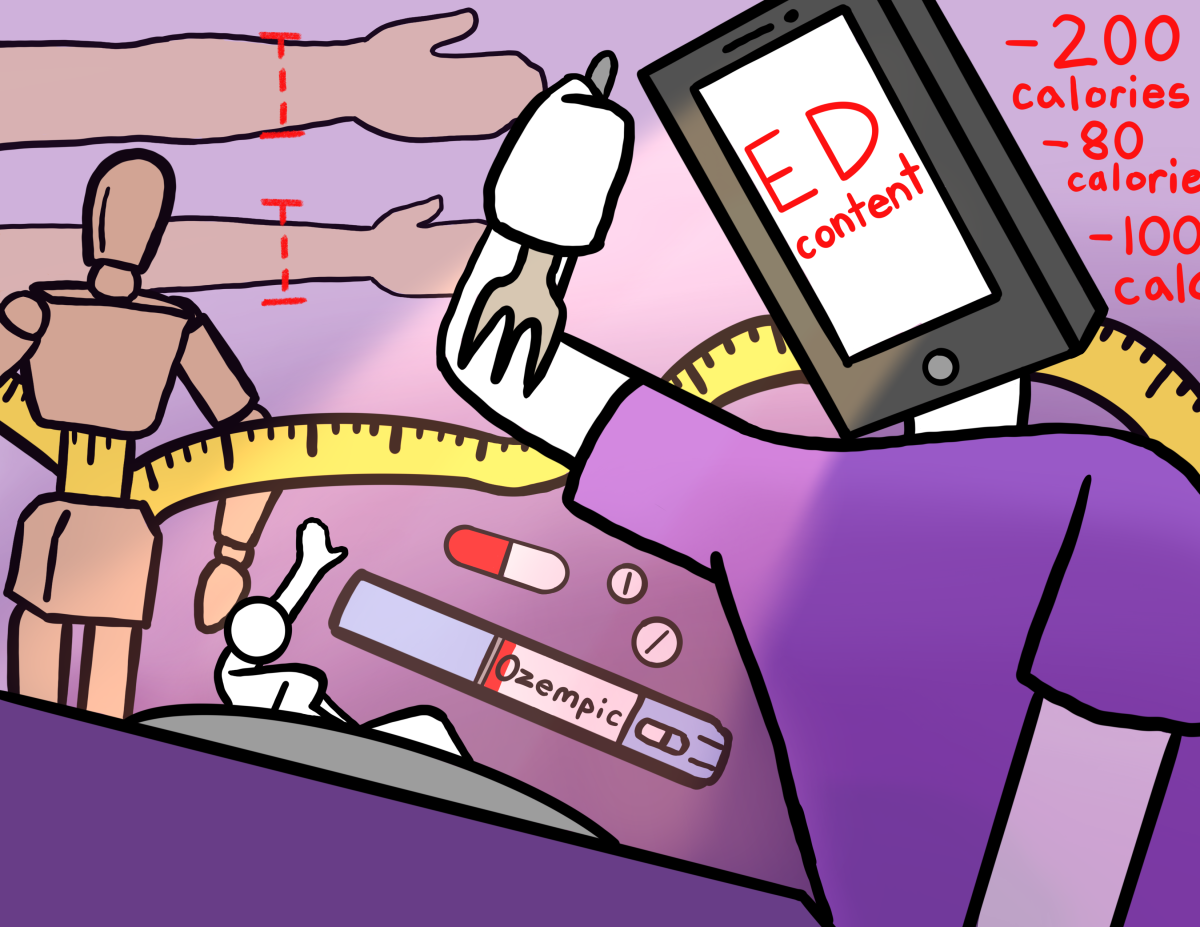
While looking in a mirror, it is easy for people to tear apart their self-esteem as thoughts of what they wish their body looked like clouds their head. With every meal, their mind envisions a pound of fat gained or an additional crease on their body. As they open their phone, they are instantly greeted with countless reminders that they fall short of society’s expectations of beauty. This is simply one of the many experiences students with a negative body image face
According to Medical News Today, “body image refers to a person’s emotional attitudes, beliefs, and perceptions of their own body.” It relates to their beliefs about their appearance and how they feel about their body. It can be positive or negative.
Holding a negative body image can lead to the development of eating disorders.
Psychology Of It All
“I pretty much judge myself everyday,” junior Sarah Stricker said. “People constantly tell me I’m pretty, and I don’t think I am.”
Stricker was told by someone close to her in sixth grade that she was starting to get heavier, causing her to become self-conscious about her weight and body image. Ever since then, Stricker looks in the mirror every morning and finds something negative about herself.
“Nothing is ever good enough for anyone,” Stricker said. “It’s like she’s too skinny; he’s too fat. Her waist isn’t big enough for her body. He probably doesn’t eat anything; he needs to eat more. She doesn’t eat enough; she should eat this instead of that.”
Holding a negative image of one’s body can sometimes escalate into an eating disorder. Most of the time people with eating disorders realize that their eating habits are unhealthy, but choose to ignore it to fit in with the social norm of being “skinny.”
According to Eating Disorder Hope, an organization designed to educate the public on eating disorders, smoking and vaping are used by many as a way to suppress appetite, although it does not affect a person’s weight loss.
When asked in a survey to define eating disorders, about three-fourths of the 330 students surveyed at Marjory Stoneman Douglas High School responded by saying it is when you limit what you eat or starve yourself, resulting in harm to the body.
However, that is only half correct; an eating disorder by definition of the Oxford dictionary is “any of a range of psychological disorders characterized by abnormal or disturbed eating habits.”
There is not just one type of eating disorder. The most common are anorexia nervosa, where one limits their food intake; bulimia nervosa, where one purges after eating; and binge eating, where one eats large amounts of food rapidly.
These disorders can be brought out by a variety of triggers including trauma, social media influence and low self-esteem.
Most eating disorders are triggered by dieting, especially in adolescents. When a person restricts their calorie intake, the body reduces the rate it burns energy, which can lead to binge eating or overeating. According to the National Eating Disorder Association, adolescents who participate in moderate dieting, where one avoids a certain amount of calories or a particular food, are five times more likely to develop an eating disorder. Those who diet with extreme restrictions, where one’s diet is severely limited in calories, are 18 times more likely.
Despite those risks, dieting has become normalized in society today. Eating disorders are becoming more common in society, as 46% of 9 to 11 year olds and 83% of families are on diets. According to Resource and Markets, the world’s largest research market store, the weight loss market was worth $72 million in 2019.
Eating disorders in both males and females are most commonly developed during the adolescent years and early stages of adulthood. This is because the adolescent brain is vulnerable to more psychological risks than at any other stages of brain development, including low self esteem, perfectionism and being a “people pleaser.” According to a study done by researchers Emma Sands and Jane Wardle published in the International Journal of Eating Disorders, 50% of 9-12 year old girls want to have thinner bodies.
“If someone has been given messages about their weight, shape or size from a young age and encouraged to diet from a young age, it could lead to thoughts and behaviors associated with eating disorders,” licensed Marriage and Family Therapist Melissa Rosen said. “Additionally, dieting can lead to the restriction of multiple food groups and becomes extreme or excessive. In today’s society, there are many fad diets out there that can impact someone who has a predisposition to develop an eating disorder.”
According to the National Eating Disorder Association, oftentimes traumatic and/or life changing events can cause a person to develop an eating disorder. Eating disorders mostly co-exist with Post Traumatic Stress Disorder, because people try to numb themselves and let out the pain they feel emotionally. About 30% of people with eating disorders are believed to have been sexually assaulted. Being abused or assaulted are not the only events that can change a person’s eating habits; a person’s parents getting divorced or a negative comment made about a person can also be triggers.
“If you are experiencing trauma-related anxiety, it would make sense that one of the ways you would try to control living in a chaotic, unpredictable world would be being very controlling about what you eat and what goes into your body,” school psychologist Jessica McBride said.
The longing for control, that can eventually lead to eating disorders, can be induced by not only traumatic events, but also other drastic lifestyle changes.
Freshman Angeline Francis has had a past of purging and binging; however, she was never officially diagnosed. She started these habits when her parents divorced, and she was told by her father’s girlfriend that she was overweight.
“My father started dating another woman, and that woman told me I needed to do some extreme exercise to lose weight,” Francis said. “Thus causing me to constantly feel as if I’m too fat or that I don’t look good because of my weight.”
Social Media’s Impact
In a survey of 330 MSD students, 67% said that social media creates both a negative and positive stigma around body image. When asked to explain their answer, most said that social media allows them to compare themselves to models and people with the “ideal” body, causing them to have negative thoughts about themselves and their bodies.
“It annoys me,” Stricker said. “Society has this picture perfect body they want everyone to be that, so they exploit it all over social media.”
However, many students said that so-called “influencers” talk about awareness for eating disorders and negative body image. Some of these influencers include Demi Lovato, who has opened up about her struggle with eating disorders in the past; Jennifer Lawerence, who strongly denounced the concept of an “ideal” body; Tyra Banks, who advocated for more diverse body types in the modeling industry; and Prince Fielder, who was criticized for his “plus-sized” body.
Even though there are many influencers trying to advocate that there is no “ideal” body, over 87% of women and 65% of men compare their bodies to those they see on social media, according to a study conducted by the Florida House Experience, a healthcare institute.
“For teenagers, the combined weight of vulnerability, the need for validation, and a desire to compare themselves with peers forms what [they] describes as a ‘perfect storm of self-doubt,’” Donna Wick, EdD, founder of Mind-to-Mind Parenting said, according to an article on the Child Mind Institute website.
While many magazines and clothing companies employ and support diverse models in size, color and shape, Aerie is one of the main clothing brands that have shown diversity within their models, beginning in 2016. Since then, they have expanded to using models with noticeable medical equipment including crutches and insulin pumps. This new modeling trend creates a sense of inclusivity and while many social platforms create a negative sense of self image, this is a step towards positive body image standards.
Not only are magazines and brands becoming more diverse, but they are also bringing light to the stereotypes around body image. Teen Vogue published an article about how fat is not a bad word, but rather a descriptive word and should not be talked about as an insult.
“The fact that [brands] are including different body sizes and encouraging that no matter what body type you are, you are beautiful, is amazing,” sophomore Kaidyn Jordan said.
According to the Associated Press, the weight loss market in the U.S. is at a record high, but the number of dieters is falling as a result of the growing support for body positivity movements.
“Body positivity movements are important as they encourage people to be happy with themselves,” senior Madeline Colombo said. “It allows people to love themselves for who they are.”
Photoshop and other photo editing apps also play a part in the “ideal” body on social media. These programs allow people to change the way they look from their body shape and hair length, to their eye color and skin texture. According to TruePic, a video and photo verification platform, about two-thirds of all Americans who post photos online have edited them before posting it.
John Rankin Waddell, a British photographer, created a photo project called “Selfie Harm,” in which he recruited fifteen teenagers and took their portraits. He then told them to edit the portraits of themselves until it was social media ready and up to their own standards. When the teenagers were done Rankin compared the edited version to the original, in which most of their facial features were changed. The teenagers made them appeal more doll-like with bigger eyes and smaller noses.
“[Photo editing software] can cause people to believe that they are not good enough, if they don’t look a certain way,” Rosen said. “It can lead people to begin to make choices to change their image and body significantly, leading to body image issues and eating disorders.”
Issues concerning dietary habits and self image have plagued the youth for generations. According to the National Center for Biotechnology Information, eating disorders and unhealthy body images have been around since the middle ages.
Health Risks
Eating disorders affect a person’s mental and physical health and can sometimes be life threatening. When a person develops an eating disorder, their body systems are compromised.
“Patients with eating disorders can also present to the emergency department for a variety of conditions such as dizziness, lightheadedness, loss of consciousness, seizures (which can be related to electrolyte disturbance as a result of their eating disorder), and heart palpitations or other cardiac issues,” Medical Director for the Rosewood Centers for Eating Disorders Amelia Davis said in an article on the Rosewood Centers’ website on June 2, 2016.
Keeping calories from one’s body allows tissue to break down and thin out, which can lead to organ failure. Low heart rate and blood pressure put one at risk for heart failure. The decrease of electrolytes caused by vomiting or purging may cause irregular heart rate and possible heart failure.
According to the National Eating Disorder Association, eating disorders cause the most health problems in the stomach and intestinal region. They cause stomach pain, bloating, blocked intestines, infections, vomiting, fluctuating blood sugar and more.
Failing to take in enough calories and then trying to compensate by binge eating can lead to obsessive thoughts about food and one’s intake. It can also lead to seizures, muscle cramps, dizziness and sleep apnea.
The National Eating Disorder Association has reported that the crude mortality rate for anorexia is 4.0%, bulimia nervosa is 3.9% and other eating disorders is 5.2%.
Recovery and Help
The path to recovering from an eating disorder is different for everyone. It can take anywhere from months to years to completely recover. Throughout the recovery process, there can be multiple relapses which can be triggered by anything, from trauma to common stress.
There are multiple types of treatments for eating disorders, including over the phone therapy and in-patient therapy. Within these treatments, medical professionals will talk and create a plan for an individual to follow to get them onto the road of recovery.
According to the National Eating Disorder Association, the most important way to recovery is through therapy. Different people go through different types of therapy depending on their condition, including group therapy and one-on-one therapy.
Broward County Public Schools will refer any student who is suffering with an eating disorder to the school’s social worker, while faculty is referred to the department’s early intervention program, according to the county’s Health Services Department.
If you or someone you know is struggling with an eating disorder or would like to know more, contact the National Eating Disorder hotline at (800) 931-2237.
This story was originally published in the March 2020 Eagle Eye print edition.








![National Honor Society Sponsor Lauren Saccomanno watches guest speaker Albert Price speak to NHS members. National Honor Society held their monthly meeting with Price on Monday, Nov. 4. "[Volunteering] varies on the years and the month, but we have started a couple new things; one of our officers Grace started a soccer program," Saccomanno said. "We have been able to continue older programs, too, like tutoring at Riverglades. NHS's goal is to have as many service projects as possible."](https://eagleeye.news/wp-content/uploads/2024/11/xNOeKNVwu7aErpVyJHrHogagZUUcLLosjtbIat94-1200x900.jpg)

![Ice Ice Baby. Skating to "Waltz" and "Romance" during her long program, figure skater Ava Zubik competes at the Cranberry Open in Massachusetts on Aug. 12, 2022. She scored a total of 86.90 on her short and free skate program, earning fifth place overall. "I try to make it [competing] as fun and enjoyable as I can because it's my senior year, and so I want to really enjoy competitive figure skating while it lasts," Zubik said.](https://eagleeye.news/wp-content/uploads/2024/11/skater1-799x1200.jpg)

